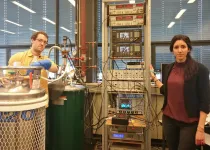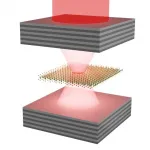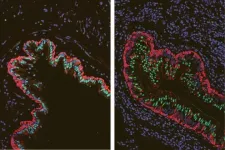Stem cell-based vaccine offers a new approach that may protect against pancreatic cancer
Mouse study shows
2021-05-06
(Press-News.org) New research by Joseph Wu, Edgar Engelman, and colleagues at Stanford University, US has advanced an old concept to develop a new strategy to train the immune system of mice to recognize cancer cells. This work is based on the recent understanding that induced pluripotent stem cells (iPSCs), which are stem cells generated from skin or blood cells through a method called reprogramming, produce a large set of antigens that have overlap to a specific type of pancreatic cancer and that these similarities can be used for potential clinical benefit.
It is well known that vaccines can be highly effective in preventing infections by training the immune system to recognize agents foreign to the body, such as viruses, and to eliminate them. Vaccines trigger the immune system by presenting so-called antigens, such as proteins not normally present in the body, which are then recognized as foreign by the immune system and therefore trigger an immune response. Less known, and still in the early stages, are vaccines against cancer. Tumor cells often contain unique antigens that are rare or not found in other tissues of the body and, like antigens from a virus, can be targets for the immune system.
To date, it has been a challenge to develop an effective and durable (lasting) vaccine against tumors. In this study, recently published in Stem Cell Reports, the researchers capitalized on the knowledge that iPSCs produce antigens that are also found on different types of tumors, but not present in most normal tissue. They then vaccinated mice with the iPSCs that were treated with irradiation, so that they would not divide, and a CpG adjuvant to stimulate a robust immune response. Their hope was to train the mice's immune systems to mount a response against the iPSCs, or any type of cell with a similar antigen makeup, including cancer cells.
The results of the study are insightful. The iPSC vaccination protected 75% of mice subsequently injected with pancreatic cancer cells from developing tumors. Further, vaccination increased the number of tumor-targeting immune cells, and the vaccinated mice developed antibodies against the cancer cells. As this iPSC-based vaccine targets many cancer antigens simultaneously, this vaccination approach may be more durable as tumor cells may be left with fewer ways of escaping recognition by the vaccine-trained immune system. What's more, this strategy may also work for other cancer types with similar antigen makeup to iPSCs. Further studies are required to show if iPSC cancer vaccines are safe and effective in patients, both in preventing tumor growth or re-growth and in eliminating established tumors.
INFORMATION:
About Stem Cell Reports
Stem Cell Reports is the Open Access journal of the International Society for Stem Cell Research, publishing discoveries in basic stem cell research, translation, and clinical applications. Stem Cell Reports focuses on original research with conceptual or practical advances that are of broad interest to stem cell biologists and clinicians.
ELSE PRESS RELEASES FROM THIS DATE:
2021-05-06
In spintronics, the magnetic moment of electrons (spin) is used to transfer and manipulate information. An ultra-compact 2D spin-logic circuitry could be built from 2D materials that can transport the spin information over long distances and also provide strong spin-polarization of charge current. Experiments by physicists at the University of Groningen (The Netherlands) and Colombia University (USA) suggest that magnetic graphene can be the ultimate choice for these 2D spin-logic devices as it efficiently converts charge to spin current and can transfer this strong spin-polarization ...
2021-05-06
At extremely low temperatures, matter often behaves differently than in normal conditions. At temperatures only a few degrees above absolute zero (-273 degrees Celsius), physical particles may give up their independence and merge for a short time into a single object in which all the particles share the same properties. Such structures are known as Bose-Einstein Condensates, and they represent a special aggregate state of matter.
An international team of researchers led by physicists Dr Carlos Anton-Solanas and Professor Christian Schneider from the UNiversity of Oldenburg has now succeeded for the first time in generating this unusual quantum state in charge carrier complexes that are closely linked ...
2021-05-06
Hydrogen-based fuels should primarily be used in sectors such as aviation or industrial processes that cannot be electrified, finds a team of researchers. Producing these fuels is too inefficient, costly and their availability too uncertain, to broadly replace fossil fuels for instance in cars or heating houses. For most sectors, directly using electricity for instance in battery electric cars or heat pumps makes more economic sense. Universally relying on hydrogen-based fuels instead and keeping combustion technologies threatens to lock in a further fossil fuel dependency ...
2021-05-06
ROCHESTER, Minn. ? Heart disease can take a number of forms, but some types of heart disease, such as asymptomatic low ejection fraction, can be hard to recognize, especially in the early stages when treatment would be most effective. The ECG AI-Guided Screening for Low Ejection Fraction, or EAGLE, trial set out to determine whether an artificial intelligence (AI) screening tool developed to detect low ejection fraction using data from an EKG could improve the diagnosis of this condition in routine practice. Study findings are published in Nature Medicine.
Systolic low ejection fraction is defined as the heart's inability to contract strongly enough with each beat to pump at least 50% of the blood from ...
2021-05-06
What The Editorial Says: JAMA Health Forum debuts this week as a peer-reviewed, open-access, online journal focused on health policy, health care systems, and global and public health. The journal has transitioned from an online health policy channel and is the newest member of the family of JAMA Network specialty journals. The editor of JAMA Health Forum is John Z. Ayanian, M.D., M.P.P., of the University of Michigan in Ann Arbor, and the deputy editor is Melinda B. Buntin, Ph.D., of the Vanderbilt University School of Medicine in Nashville, Tennessee.
Authors: John Z. Ayanian, M.D., M.P.P., of the University of Michigan in Ann Arbor, is the corresponding author.
To access the embargoed study: Visit our For The Media website at ...
2021-05-06
What The Study Did: Researchers compared health care use among patients with COVID-19 who were enrolled in a home monitoring program with similar patients who were not enrolled.
Authors: Anita D. Misra-Hebert, M.D., M.P.H., of the Cleveland Clinic, is the corresponding author.
To access the embargoed study: Visit our For The Media website at this link https://media.jamanetwork.com/
(doi:10.1001/jamahealthforum.2021.0333)
Editor's Note: The article includes conflict of interest and funding/support disclosures. Please see the article for additional information, including other authors, author contributions and affiliations, conflict of interest and financial disclosures, and funding and support.
INFORMATION:
Media advisory: The full study and editor's ...
2021-05-06
New York, NY (May 6, 2021) -- Researchers have finally cracked the code of a bewildering pediatric disease that sets off a characteristic cytokine storm--a harmful immune system overaction resembling one that arises in COVID-19 cases--and can lead to catastrophic multisystem organ failure or neurodegeneration. Their study, which identifies the cause of the cytokine storm and possible treatments, was published in Nature Medicine in May.
The mystery of this disease, Langerhans-cell histiocytosis (LCH), runs deep. Its symptoms vary widely, and LCH has the ability to infiltrate almost any organ system, leaving most patients with long-term ...
2021-05-06
A team of researchers from UCLA, Cedars-Sinai and the Cystic Fibrosis Foundation has developed a first-of-its-kind molecular catalog of cells in healthy lungs and the lungs of people with cystic fibrosis.
The catalog, described today in the journal Nature Medicine, reveals new subtypes of cells and illustrates how the disease changes the cellular makeup of the airways. The findings could help scientists in their search for specific cell types that represent prime targets for genetic and cell therapies for cystic fibrosis.
"This new research has provided us with valuable insights into the cellular makeup of both healthy and diseased airways," said Dr. Brigitte Gomperts, a co-senior author of the study and a member of the Eli and Edythe Broad Center of Regenerative ...
2021-05-06
Obesity may be a stronger risk factor for death, severe pneumonia and the need for intubation in men than in women with COVID-19, according to a study published in the European Journal of Clinical Microbiology & Infectious Diseases.
An analysis of a cohort of 3530 COVID-19 patients showed that both moderate (BMI of 35/m2 or higher) and severe obesity (BMI of 40kg/m2 and higher) in men but only severe obesity in women (BMI of 40kg/m2 and higher) was associated greater risk of developing severe disease, needing intubation and dying from COVID-19 in hospital.
Previous research demonstrated that obesity is a risk factor for hospitalization, severe disease, and death in patients with COVID-19. ...
2021-05-06
Bacteria contain symmetry in their DNA signals that enable them to be read either forwards or backwards, according to new findings at the University of Birmingham which challenge existing knowledge about gene transcription.
In all living organisms, DNA code is divided into sections which provide information about a specific process. These must be read before the information can be used. Cells identify the start of each section using 'signposts', which scientists first identified in the 1960s.
It has always been assumed that these signposts enable genetic sequences ...
LAST 30 PRESS RELEASES:
[Press-News.org] Stem cell-based vaccine offers a new approach that may protect against pancreatic cancer
Mouse study shows


